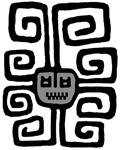Center, Textile Research

PreColumbian Textile Conference VIII / Jornadas de Textiles PreColombinos VIII (2019)
Date of this Version
6-2020
Document Type
Article
Citation
DOI: 10.32873/unl.dc.zea.1211
Published in PreColumbian Textile Conference VIII / Jornadas de Textiles PreColombinos VIII, ed. Lena Bjerregaard and Ann Peters (Lincoln, NE: Zea Books, 2020). https://digitalcommons.unl.edu/zeabook/
Abstract
Se estudia en este texto un extraordinario tapiz que resalta por una decoración que combina símbolos incaicos, con aspecto de tocapus, con una cruz cristiana. Forma parte de una investigación mayor dedicada al tapiz andino colonial próxima a divulgarse. Actualmente, no se conoce otro ejemplar semejante en el Perú ni en el extranjero y probablemente se trata de uno de los tapices coloniales más antiguos. Tuvimos la fortuna de darlo a conocer en los seminarios del Doctorado del Programa de Estudios Andinos de la Pontificia Universidad Católica del Perú y en otros eventos desde el año 2014. Se halla en el depósito de textiles del Museo Nacional de Arqueología, Antropología e Historia del Perú y no cuenta con datos de contexto. Está tejido con técnicas y fibras andinas tradicionales (algodón y camélido). Sobresalen los colores contrastantes y principalmente el diseño híbrido en el que las formas geométricas y estilizadas del lenguaje gráfico inca aparecen junto a un símbolo católico. Analizamos tanto la iconografía, como la técnica del tejido, los usos y posibles propietarios. La pieza muestra una continuidad del tejido andino ancestral pues varias características estructurales son parte del patrón de estandarización del tejido impuesto por el Estado inca para la elaboración de los uncus destinados a las élites. Ello revela que el tejido de cumbi (tejido fino de los incas) trascendió a los convulsos momentos de la conquista y pervivió en formato y función distintos.
We study here an extraordinary tapestry, unusual due to a decorative program that combines Inca symbols resembling tocapus with a Christian cross. It is part of a larger investigation dedicated to colonial Andean tapestry that is soon to be published. No other similar specimen is known in Peru or abroad and it is probably one of the oldest known colonial tapestry. We have been fortunate to first present it in the seminars of the doctoral program in Andean Studies of the Pontifical Catholic University of Peru and in other events since 2014. It is located in the textile storage facility of the National Museum of Archeology, Anthropology and History of Peru and has no contextual data. It was woven with Andean traditional techniques and fibers (cotton and camelid). The contrasting colors stand out and particularly the hybrid design in which the geometric and stylized elements of the Inca graphic language appear next to a Catholic symbol. We analyze the iconography as well as the technique of the fabric, its uses and possible owners. The tapestry shows continuity in the ancient Andean textiles as several structural characteristics are part of the policy of standardization of weaving imposed by the Inca State for the elaboration of uncu tunics for the elite men. This reveals that cumbi fabric (fine Inca cloth) transcended the convulsive first moments of the conquest and survived in a different format and function.
Nous étudions dans cet article un extraordinaire tapis qui attire l’attention par sa décoration combinant des symboles incas semblables aux tocapus, avec la croix chrétienne. Ce dernier fait partie d’une recherche majeure dédiée aux tapis andins coloniaux à paraître prochainement. Nous ne connaissons pas un autre exemplaire semblable au Pérou ni à l’étranger et probablement il s’agit du tapis colonial le plus ancien. Nous avons eu la chance de le faire connaître au cours des séminaires de Doctorat du Programme d’Etudes Andines de l’Université Pontificale Catholique du Pérou et dans d’autres évènements depuis l’année 2014. Il se trouve dans le dépôt textile du Musée National d’Archéologie, Anthropologie et Histoire du Pérou et mous ne possédons pas d’information sur son contexte. Il est tissé avec des techniques et des fibres (de coton et de camélidés) andines traditionnelles. Les colorants contrastants, et principalement le motif hybride, dans lequel se démarquent les formes géométriques et stylisées du langage graphique inca apparaissent près d’un symbole catholique. Nous analysons tant l’iconographie que la technique du tissu, ses usages et ses possibles propriétaires. Le tapis montre une continuité du tissu andin millénaire étant donné que plusieurs caractéristiques structurelles font partie du modèle de standardisation du tissu imposé par l’Etat inca pour l’élaboration des uncu destinés aux élites masculines. Cela révèle que le tissu cumbi (tissu fin des incas) a dépassé les moments mouvementés de la Conquête et a perduré dans des formats et des fonctions différentes.
Included in
Art and Materials Conservation Commons, Fiber, Textile, and Weaving Arts Commons, Indigenous Studies Commons, Latin American Languages and Societies Commons, Museum Studies Commons, Other History of Art, Architecture, and Archaeology Commons


Comments
Copyright 2020 Mg. Mónica Solórzano Gonzales